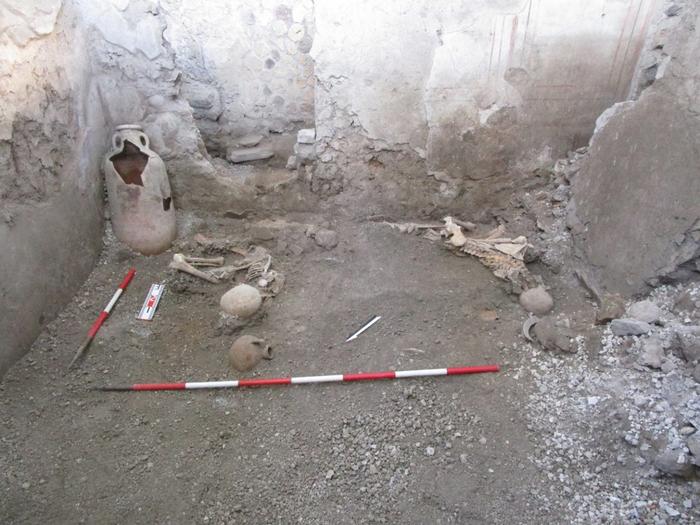New research suggests that earthquakes during the 79 CE eruption of Mount Vesuvius may have contributed significantly to the destruction of Pompeii, potentially influencing the fate of its inhabitants. The study, published in Frontiers in Earth Science, provides fresh insights into the complex interplay of volcanic and seismic events that led to one of history’s most infamous natural disasters.
Unraveling a 2,000-Year-Old Mystery
A team of researchers from the Istituto Nazionale di Geofisica e Vulcanologia (INGV) and Pompeii Archaeological Park has tackled the challenging task of differentiating between volcanic and seismic effects during the Vesuvius eruption. This distinction is crucial for understanding the full scope of the catastrophe that befell Pompeii.
Dr. Domenico Sparice, lead author of the study, explains: “These complexities are like a jigsaw puzzle in which all the pieces must fit together to unravel the complete picture. We proved that seismicity during the eruption played a significant role in the destruction of Pompeii and, possibly, influenced the choices of the Pompeiians who faced an inevitable death.”
The research team’s curiosity was piqued during excavations at the ‘Casa dei Pittori al Lavoro’ (House of the Painters at Work), where they noticed unusual characteristics in collapsed buildings that didn’t align with typical volcanic damage. The discovery of two skeletons with severe fractures and trauma injuries further fueled their investigation.
A Tale of Two Victims
The study focuses on two male skeletons, both approximately 50 years old, found in the ruins. Their positioning and condition provide crucial clues about the sequence of events during the disaster.
Dr. Valeria Amoretti, an anthropologist at Pompeii Archaeological Park, describes the grim scene: “The people who did not flee their shelters were possibly overwhelmed by earthquake-induced collapses of already overburdened buildings. This was the fate of the two individuals we recovered.”
The first individual appears to have been instantly killed by a large collapsing wall fragment. The second may have attempted to protect himself with a round wooden object, traces of which were found in the volcanic deposits.
Importantly, the positioning of these victims on top of the pumice lapilli layer, rather than beneath it, suggests they survived the initial phase of the eruption. This finding indicates that seismic activity during a lull in the eruption may have caused additional casualties, complicating our understanding of the disaster’s timeline.
Why it matters: This research provides a more nuanced understanding of one of history’s most famous natural disasters. By highlighting the role of earthquakes in Pompeii’s destruction, it offers new insights into the challenges faced by the city’s inhabitants during their final hours. This knowledge not only enhances our historical understanding but could also inform modern disaster preparedness strategies in volcanically active regions.
The study raises important questions about disaster response and human behavior in crisis situations. Dr. Gabriel Zuchtriegel, director of the Pompeii Archaeological Park, notes: “New insight into the destruction of Pompeii gets us very close to the experience of the people who lived here 2,000 years ago. The choices they made as well as the dynamics of the events, which remain a focus of our research, decided over life and death in the last hours of the city’s existence.”
While this research provides valuable new information, it also highlights the challenges of studying ancient disasters. The exact number of victims caused by volcanic effects versus earthquake damage remains unknown. Additionally, the research team acknowledges the difficulty in distinguishing between closely occurring volcanic and seismic effects.
Looking ahead, this study opens up new avenues for interdisciplinary research in archaeology, volcanology, and seismology. Future investigations may focus on developing more precise methods for differentiating between volcanic and seismic damage in archaeological sites. This could lead to a more comprehensive understanding of other historical eruptions and their impacts on human settlements.
As we continue to uncover the secrets of Pompeii, each new discovery not only illuminates the past but also provides valuable lessons for the present. The tragic fate of Pompeii’s inhabitants serves as a stark reminder of the power of natural forces and the importance of preparedness in the face of potential disasters.
If our reporting has informed or inspired you, please consider making a donation. Every contribution, no matter the size, empowers us to continue delivering accurate, engaging, and trustworthy science and medical news. Independent journalism requires time, effort, and resources—your support ensures we can keep uncovering the stories that matter most to you.
Join us in making knowledge accessible and impactful. Thank you for standing with us!

